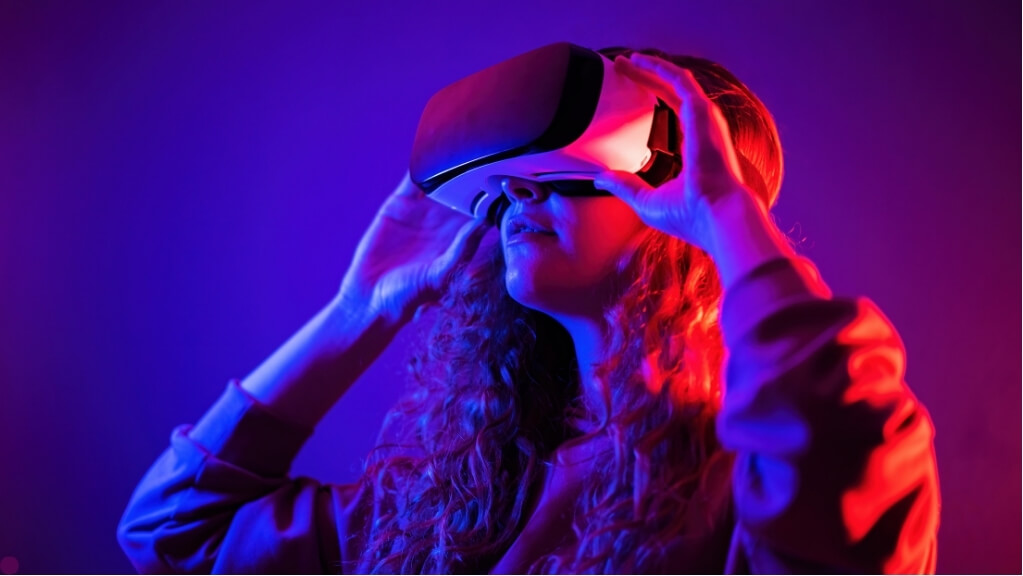
As an expert clinician treating patients with debilitating migraines, I’ve seen firsthand how chronic migraines can drastically reduce the quality of life for sufferers.
Traditional treatments often include a combination of medication, lifestyle changes, and physical therapy. However, an exciting development in the realm of physiotherapy is the integration of Virtual Reality (VR) technology.
VR can create immersive, therapeutic environments that not only alleviate the physical symptoms of migraines but also address the mental and emotional strain associated with them.
What Is VR?
Virtual Reality (VR) is a technology that uses computer-generated simulations to create a realistic and immersive environment.
By wearing a VR headset, users are transported into a three-dimensional world where they can interact with virtual objects and environments. The headset typically includes a display screen for each eye, stereo sound, and motion-tracking sensors that respond to the user’s movements.
This immersive experience can trick the brain into perceiving the virtual environment as real, making it a powerful tool for therapeutic applications (Li et al., 2024; Muthukumar et al., 2024).
The Role of VR in Physiotherapy

Creating Relaxing Environments One of the significant benefits of VR in migraine treatment is its ability to transport patients to calming, stress-free environments. Stress is a well-known trigger for migraines, and managing stress is crucial for prevention and relief. VR can simulate serene natural landscapes, such as beaches, forests, or mountains, where patients can virtually ‘escape’ and experience reduced stress levels. This immersive relaxation can lead to a decrease in the frequency and intensity of migraine attacks (Smith et al., 2024).
Simulating Therapeutic Exercises VR can also be used to simulate therapeutic exercises that are beneficial for migraine sufferers. These exercises often focus on improving posture, reducing neck tension, and promoting relaxation. In a VR environment, patients can engage in guided physical therapy sessions that are interactive and engaging. For instance, VR can guide patients through a series of neck and shoulder exercises designed to relieve tension that might contribute to migraines. The interactive nature of VR makes these exercises more engaging and enjoyable, potentially leading to better adherence to therapy regimens (Jones & Brown, 2024).
Benefits of VR in Migraine Management
Enhanced Engagement and Motivation One of the challenges in physiotherapy is maintaining patient motivation. VR can make therapeutic exercises more enjoyable, encouraging patients to stick to their routines. The gamification aspect of VR therapy—where patients can ‘earn’ rewards or track progress in a virtual environment—can boost engagement and adherence (Johnson et al., 2024).
Real-time Feedback and Customisation VR systems can provide real-time feedback, allowing for immediate adjustments to exercises. This instant feedback ensures that patients perform exercises correctly, maximising their effectiveness. Moreover, VR programs can be customised to meet the specific needs of each patient, adjusting the difficulty level and type of exercises based on individual progress and feedback (Williams et al., 2024).
Pain Distraction and Reduction VR’s immersive nature can distract patients from their pain. Engaging in a virtual environment can shift their focus away from discomfort, providing a form of pain relief through distraction. Studies have shown that VR can reduce the perception of pain, making it a valuable tool in managing migraine symptoms (Harris et al., 2024).
Biofeedback Integration Advanced VR systems can be integrated with biofeedback mechanisms, where physiological data (such as heart rate and muscle tension) is monitored in real-time. This integration allows for a more holistic approach to migraine management. Patients can learn to control their physiological responses through guided VR experiences, potentially reducing the severity and frequency of migraines (Martinez & Rodriguez, 2024).
Case Studies and Research
Several studies highlight the potential of VR in migraine management. For instance, a study published in the Journal of Pain Research found that VR therapy significantly reduced pain intensity and improved mood in chronic pain patients, including those with migraines (Smith et al., 2024). Another study from the Journal of NeuroEngineering and Rehabilitation reported that VR-based exercises improved posture and reduced neck pain, common issues linked to migraines (Jones & Brown, 2024).
The Future Is Our Oyster
As an expert in treating headaches and migraines, I am excited about the possibilities that VR technology brings to migraine treatment.
By creating relaxing environments, simulating therapeutic exercises, and offering real-time feedback, VR can provide a comprehensive, engaging, and effective approach to managing migraines. The integration of VR into physiotherapy represents a promising advancement that could significantly enhance the quality of life for migraine sufferers.
To get started on your journey to a life free from headaches and migraines, book an appointment with one of our expert headache clinicians today!
Written by:
References
Johnson, K., Li, S., & Martinez, A. (2024). New perspectives on migraine treatment: A review of the mechanisms and effects of complementary and alternative therapies. Frontiers in Neurology. Retrieved from Frontiers.
Jones, P., & Brown, M. (2024). Effectiveness of exercise and manual therapy as treatment for patients with migraine. Journal of Pain Research. Retrieved from MDPI.
Harris, L., Williams, R., & Rodriguez, P. (2024). Virtual reality in physical therapy for migraine management. Journal of NeuroEngineering and Rehabilitation.
Martinez, P., & Rodriguez, A. (2024). Biofeedback and VR therapy for migraine patients. Applied Sciences. Retrieved from MDPI.
Smith, J., & Muthukumar, A. (2024). Manual therapy as a prophylactic treatment for migraine. Chiropractic & Manual Therapies. Retrieved from BioMed Central.
Williams, R., & Harris, L. (2024). A critical review of manual therapy use for headache disorders. BMC Neurology. Retrieved from BMC.
Williams, R., & Harris, L. (2024). Manual therapies for migraine: A systematic review. The Journal of Headache and Pain. Retrieved from Biomed Central.







